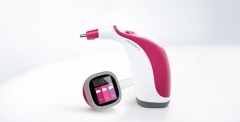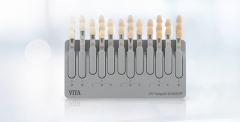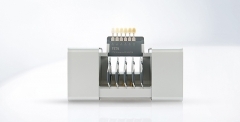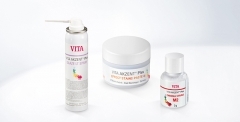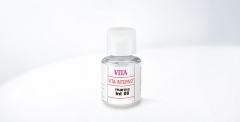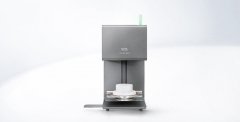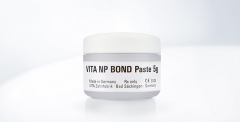VITA VMK Master is a natural feldspar veneering ceramic for conventional bonding alloys (approx. 13.8 – 15.2 µm/mK).
Regardless of whether the conventional alloys are cast, milled or sintered.
Precise
An uncompromising material when it comes to reliability and processing.
Intuitive
Classic and established dentin-incisal layering pattern.
Esthetic
Highly esthetic restorations, thanks to brilliant colors.
VITA VMK Master® VITA classical A1-D4®
VITA VMK Master OPAQUE PASTE, 5 g
|
Description
|
Prod. no. 5 g
|
|---|
|
A1
|
B483015
|
|
A2
|
B483025
|
|
A3
|
B483035
|
|
A3.5
|
B483045
|
|
A4
|
B483055
|
|
B1
|
B483065
|
|
B2
|
B483075
|
|
B3
|
B483085
|
|
B4
|
B483095
|
|
C1
|
B483105
|
|
C2
|
B483115
|
|
C3
|
B483125
|
|
C4
|
B483135
|
|
D2
|
B483145
|
|
D3
|
B483155
|
|
D4
|
B483165
|
VITA VMK Master OPAQUE, 12 g / 50 g / 250 g
|
Description
|
Prod. no. 12 g
|
Prod. no. 50 g
|
Prod. no. 250 g
|
|---|
|
A1
|
B4840112
|
B4840150
|
B48401250
|
|
A2
|
B4840212
|
B4840250
|
B48402250
|
|
A3
|
B4840312
|
B4840350
|
B48403250
|
|
A3.5
|
B4840412
|
B4840450
|
-
|
|
A4
|
B4840512
|
B4840550
|
-
|
|
B1
|
B4840612
|
B4840650
|
-
|
|
B2
|
B4840712
|
B4840750
|
-
|
|
B3
|
B4840812
|
B4840850
|
-
|
|
B4
|
B4840912
|
B4840950
|
-
|
|
C1
|
B4841012
|
B4841050
|
-
|
|
C2
|
B4841112
|
B4841150
|
-
|
|
C3
|
B4841212
|
B4841250
|
-
|
|
C4
|
B4841312
|
B4841350
|
-
|
|
D2
|
B4841412
|
B4841450
|
-
|
|
D3
|
B4841512
|
B4841550
|
-
|
|
D4
|
B4841612
|
B4841650
|
-
|
VITA VMK Master OPAQUE DENTINE, 12 g / 50 g
|
Description
|
Prod. no. 12 g
|
Prod. no. 50 g
|
|---|
|
A1
|
B4843112
|
B4843150
|
|
A2
|
B4843212
|
B4843250
|
|
A3
|
B4843312
|
B4843350
|
|
A3.5
|
B4843412
|
B4843450
|
|
A4
|
B4843512
|
B4843550
|
|
B1
|
B4843612
|
B4843650
|
|
B2
|
B4843712
|
B4843750
|
|
B3
|
B4843812
|
B4843850
|
|
B4
|
B4843912
|
B4843950
|
|
C1
|
B4844012
|
B4844050
|
|
C2
|
B4844112
|
B4844150
|
|
C3
|
B4844212
|
B4844250
|
|
C4
|
B4844312
|
B4844350
|
|
D2
|
B4844412
|
B4844450
|
|
D3
|
B4844512
|
B4844550
|
|
D4
|
B4844612
|
B4844650
|
VITA VMK Master DENTINE, 12 g / 50 g / 250 g
|
Description
|
Powder no.
|
Prod. no. 12 g
|
Prod. no. 50 g
|
Prod. no. 250 g
|
|---|
|
A1
|
EN1
|
B4845112
|
B4845150
|
B48451250
|
|
A2
|
EN1
|
B4845212
|
B4845250
|
B48452250
|
|
A3
|
EN1
|
B4845312
|
B4845350
|
B48453250
|
|
A3.5
|
EN2
|
B4845412
|
B4845450
|
B48454250
|
|
A4
|
EN2
|
B4845512
|
B4845550
|
-
|
|
B1
|
EN2
|
B4845612
|
B4845650
|
B48456250
|
|
B2
|
EN2
|
B4845712
|
B4845750
|
B48457250
|
|
B3
|
EN2
|
B4845812
|
B4845850
|
-
|
|
B4
|
EN2
|
B4845912
|
B4845950
|
-
|
|
C1
|
EN2
|
B4846012
|
B4846050
|
B48460250
|
|
C2
|
EN2
|
B4846112
|
B4846150
|
B48461250
|
|
C3
|
EN1
|
B4846212
|
B4846250
|
B48462250
|
|
C4
|
EN1
|
B4846312
|
B4846350
|
-
|
|
D2
|
EN2
|
B4846412
|
B4846450
|
B48464250
|
|
D3
|
EN2
|
B4846512
|
B4846550
|
-
|
|
D4
|
EN2
|
B4846612
|
B4846650
|
-
|
VITA VMK Master® VITA SYSTEM 3D-MASTER®
VITA VMK Master DENTINE, 12 g / 50 g / 250 g
|
Description
|
Powder no.
|
Prod. no. 12 g
|
Prod. no. 50 g
|
Prod. no. 250 g
|
|---|
|
0M1
|
EN1
|
B4803112
|
B4803150
|
-
|
|
0M2
|
EN1
|
B4803212
|
B4803250
|
-
|
|
0M3
|
EN1
|
B4803312
|
B4803350
|
-
|
|
1M1
|
EN1
|
B4803412
|
B4803450
|
B48034250
|
|
1M2
|
EN1
|
B4803512
|
B4803550
|
B48035250
|
|
2L1.5
|
EN1
|
B4803612
|
B4803650
|
B48036250
|
|
2L2.5
|
EN1
|
B4803712
|
B4803750
|
-
|
|
2M1
|
EN1
|
B4803812
|
B4803850
|
B48038250
|
|
2M2
|
EN1
|
B4803912
|
B4803950
|
B48039250
|
|
2M3
|
EN1
|
B4804012
|
B4804050
|
-
|
|
2R1.5
|
EN1
|
B4804112
|
B4804150
|
-
|
|
2R2.5
|
EN1
|
B4804212
|
B4804250
|
B48042250
|
|
3L1.5
|
EN1
|
B4804312
|
B4804350
|
-
|
|
3L2.5
|
EN1
|
B4804412
|
B4804450
|
-
|
|
3M1
|
EN1
|
B4804512
|
B4804550
|
-
|
|
3M2
|
EN1
|
B4804612
|
B4804650
|
B48046250
|
|
3M3
|
EN1
|
B4804712
|
B4804750
|
-
|
|
3R1.5
|
EN1
|
B4804812
|
B4804850
|
-
|
|
3R2.5
|
EN3
|
B4804912
|
B4804950
|
-
|
|
4L1.5
|
EN1
|
B4805012
|
B4805050
|
-
|
|
4L2.5
|
EN1
|
B4805112
|
B4805150
|
-
|
|
4M1
|
EN1
|
B4805212
|
B4805250
|
-
|
|
4M2
|
EN3
|
B4805312
|
B4805350
|
-
|
|
4M3
|
EN3
|
B4805412
|
B4805450
|
-
|
|
4R1.5
|
EN1
|
B4805512
|
B4805550
|
-
|
|
4R2.5
|
EN3
|
B4805612
|
B4805650
|
-
|
|
5M1
|
EN1
|
B4805712
|
B4805750
|
-
|
|
5M2
|
EN3
|
B4805812
|
B4805850
|
-
|
|
5M3
|
EN3
|
B4805912
|
B4805950
|
-
|
VITA VMK Master OPAQUE DENTINE, 12 g / 50 g
|
Description
|
Prod. no. 12 g
|
Prod. no. 50 g
|
|---|
|
0M1
|
B4806112
|
B4806150
|
|
0M2
|
B4806212
|
B4806250
|
|
0M3
|
B4806312
|
B4806350
|
|
1M1
|
B4806412
|
B4806450
|
|
1M2
|
B4806512
|
B4806550
|
|
2L1.5
|
B4806612
|
B4806650
|
|
2L2.5
|
B4806712
|
B4806750
|
|
2M1
|
B4806812
|
B4806850
|
|
2M2
|
B4806912
|
B4806950
|
|
2M3
|
B4807012
|
B4807050
|
|
2R1.5
|
B4807112
|
B4807150
|
|
2R2.5
|
B4807212
|
B4807250
|
|
3L1.5
|
B4807312
|
B4807350
|
|
3L2.5
|
B4807412
|
B4807450
|
|
3M1
|
B4807512
|
B4807550
|
|
3M2
|
B4807612
|
B4807650
|
|
3M3
|
B4807712
|
B4807750
|
|
3R1.5
|
B4807812
|
B4807850
|
|
3R2.5
|
B4807912
|
B4807950
|
|
4L1.5
|
B4808012
|
B4808050
|
|
4L2.5
|
B4808112
|
B4808150
|
|
4M1
|
B4808212
|
B4808250
|
|
4M2
|
B4808312
|
B4808350
|
|
4M3
|
B4808412
|
B4808450
|
|
4R1.5
|
B4808512
|
B4808550
|
|
4R2.5
|
B4808612
|
B4808650
|
|
5M1
|
B4808712
|
B4808750
|
|
5M2
|
B4808812
|
B4808850
|
|
5M3
|
B4808912
|
B4808950
|
VITA VMK Master OPAQUE, 12 g / 50 g / 250 g
|
Description
|
Prod. no. 12 g
|
Prod. no. 50 g
|
Prod. no. 250 g
|
|---|
|
OP0
|
B4825012
|
B4825050
|
-
|
|
OP1
|
B4825112
|
B4825150
|
B48251250
|
|
OP2
|
B4825212
|
B4825250
|
B48252250
|
|
OP3
|
B4825312
|
B4825350
|
B48253250
|
|
OP4
|
B4825412
|
B4825450
|
-
|
|
OP5
|
B4825512
|
B4825550
|
-
|
VITA VMK Master OPAQUE PASTE, 5 g
|
Description
|
Prod. no. 5 g
|
|---|
|
OP0
|
B483505
|
|
OP1
|
B483515
|
|
OP2
|
B483525
|
|
OP3
|
B483535
|
|
OP4
|
B483545
|
|
OP5
|
B483555
|
VITA VMK Master® Additional Powder
compatible with VITA SYSTEM 3D-MASTER and VITA classical A1-D4 shades
VITA VMK Master TRANSLUCENT, 12 g / 50 g / 250 g
|
Description
|
Prod. no. 12 g
|
Prod. no. 50 g
|
Prod. no. 250 g
|
|---|
|
T1
|
B4809112
|
-
|
-
|
|
T2
|
B4809212
|
-
|
-
|
|
T3
|
B4809312
|
-
|
-
|
|
T4
|
B4809412
|
B4809450
|
B48094250
|
|
T5
|
B4809512
|
-
|
-
|
|
T6
|
B4809612
|
-
|
-
|
|
T7
|
B4809712
|
-
|
-
|
|
T8
|
B4809812
|
-
|
-
|
VITA VMK Master DENTINE MODIFIER, 12 g
|
Description
|
Prod. no. 12 g
|
|---|
|
DM1
|
B4812112
|
|
DM2
|
B4812212
|
|
DM3
|
B4812312
|
|
DM4
|
B4812412
|
|
DM5
|
B4812512
|
|
DM6
|
B4812612
|
|
DM7
|
B4812712
|
|
DM8
|
B4812812
|
VITA VMK Master LUMINARY, 12 g
|
Description
|
Prod. no. 12 g
|
|---|
|
LM1
|
B4814112
|
|
LM2
|
B4814212
|
|
LM3
|
B4814312
|
|
LM4
|
B4814412
|
|
LM5
|
B4814512
|
|
LM6
|
B4814612
|
VITA VMK Master PEARL TRANSLUCENT, 12 g
|
Description
|
Prod. no. 12 g
|
|---|
|
PLT1
|
B4815112
|
VITA VMK Master OPAL TRANSLUCENT, 12 g
|
Description
|
Prod. no. 12 g
|
|---|
|
OT1
|
B4817112
|
VITA VMK Master WINDOW, 12 g / 50 g / 250 g
|
Description
|
Prod. no. 12 g
|
Prod. no. 50 g
|
Prod. no. 250 g
|
|---|
|
WIN
|
B4818112
|
B4818150
|
B48181250
|
VITA VMK Master ENAMEL, 12 g / 50 g / 250 g
|
Description
|
Prod. no. 12 g
|
Prod. no. 50 g
|
Prod. no. 250 g
|
|---|
|
EN1
|
B4819112
|
B4819150
|
B48191250
|
|
EN2
|
B4819212
|
B4819250
|
B48192250
|
|
EN3
|
B4819312
|
B4819350
|
B48193250
|
VITA VMK Master CERVICAL, 12 g
|
Description
|
Prod. no. 12 g
|
|---|
|
CE1
|
B4820112
|
|
CE2
|
B4820212
|
|
CE3
|
B4820312
|
VITA VMK Master CORRECTIVE, 12 g
|
Description
|
Prod. no. 12 g
|
|---|
|
COR1
|
B4822112
|
|
COR2
|
B4822212
|
VITA VMK Master GINGIVA, 12 g
|
Description
|
Prod. no. 12 g
|
|---|
|
G1
|
B4823112
|
|
G2
|
B4823212
|
|
G3
|
B4823312
|
|
G4
|
B4823412
|
|
G5
|
B4823512
|
VITA VMK Master NECK, 12 g
|
Description
|
Prod. no. 12 g
|
|---|
|
N1
|
B4824112
|
|
N2
|
B4824212
|
|
N3
|
B4824312
|
|
N4
|
B4824412
|
|
N5
|
B4824512
|
VITA VMK Master WASH OPAQUE, 12 g / 50 g
|
Description
|
Prod. no. 12 g
|
Prod. no. 50 g
|
|---|
|
WO
|
B4825912
|
B4825950
|
VITA VMK Master MARGIN, 12 g
|
Description
|
Prod. no. 12 g
|
|---|
|
MN
|
B4826012
|
|
M1
|
B4826112
|
|
M2
|
B4826212
|
|
M3
|
B4826312
|
|
M4
|
B4826412
|
|
M5
|
B4826512
|
VITA VMK Master GINGIVA OPAQUE, 12 g
|
Description
|
Prod. no. 12 g
|
|---|
|
GOL
|
B4827112
|
|
GOD
|
B4827312
|
VITA VMK Master WASH OPAQUE PASTE, 7 g
|
Description
|
Prod. no. 7 g
|
|---|
|
WO
|
B483597
|
VITA VMK Master GINGIVA OPAQUE PASTE, 5 g
|
Description
|
Prod. no. 5 g
|
|---|
|
GOL
|
B483715
|
|
GOD
|
B483735
|
VITA VMK Master® VITA classical A1-D4®
|
|
VITA VMK Master® ONE COLOR KIT A2 One-shade kit for initial tests
BVMKOCSA2V2
|
Quantity
|
Content
|
Material
|
|---|
|
1
|
12 g
|
VITA VMK Master OPAQUE A2
| |
1
|
12 g
|
VITA VMK Master OPAQUE DENTINE A2
| |
1
|
12 g
|
VITA VMK Master DENTINE A2
| |
1
|
12 g
|
VITA VMK Master ENAMEL EN1
| |
1
|
12 g
|
VITA VMK Master TRANSLUCENT T4
| |
1
|
5 g
|
VITA AKZENT Plus GLAZE POWDER
| |
1
|
50 ml
|
VITA MODELLING FLUID RS
| |
1
|
50 ml
|
VITA OPAQUE FLUID
| |
1
|
20 ml
|
VITA AKZENT Plus POWDER FLUID
|
|
|
|
VITA VMK Master® STARTER SET classical Two-color set
BVMKSSC
|
Quantity
|
Content
|
Material
|
|---|
|
2
|
12 g
|
VITA VMK Master OPAQUE A2 - A3
| |
2
|
12 g
|
VITA VMK Master OPAQUE DENTINE A2 - A3
| |
2
|
12 g
|
VITA VMK Master DENTINE A2 - A3
| |
1
|
12 g
|
VITA VMK Master ENAMEL EN1
| |
1
|
12 g
|
VITA VMK Master TRANSLUCENT T4
| |
1
|
50 ml
|
VITA MODELLING FLUID RS
| |
1
|
50 ml
|
VITA OPAQUE FLUID
| |
1
|
|
VITA shade indicator stick A2
| |
1
|
|
VITA shade indicator stick A3
|
|
VITA VMK Master® VITA SYSTEM 3D-MASTER®
|
|
VITA VMK Master® ONE COLOR KIT 2M2 One-shade kit for initial tests
BVMKOCS2M2V2
|
Quantity
|
Content
|
Material
|
|---|
|
1
|
12 g
|
VITA VMK Master OPAQUE OP2
| |
1
|
12 g
|
VITA VMK Master OPAQUE DENTINE 2M2
| |
1
|
12 g
|
VITA VMK Master DENTINE 2M2
| |
1
|
12 g
|
VITA VMK Master ENAMEL EN1
| |
1
|
12 g
|
VITA VMK Master TRANSLUCENT T4
| |
1
|
5 g
|
VITA AKZENT Plus GLAZE POWDER
| |
1
|
50 ml
|
VITA MODELLING FLUID RS
| |
1
|
50 ml
|
VITA OPAQUE FLUID
| |
1
|
20 ml
|
VITA AKZENT Plus POWDER FLUID
|
|
|
|
VITA VMK Master® STARTER SET POWDER VITA SYSTEM 3D-MASTER® Two-color set
BVMKSS3D
|
Quantity
|
Content
|
Material
|
|---|
|
2
|
12 g
|
VITA VMK Master OPAQUE OP2 - OP3
| |
2
|
12 g
|
VITA VMK Master DENTINE 2M2, 3M2
| |
2
|
12 g
|
VITA VMK Master OPAQUE DENTINE 2M2, 3M2
| |
1
|
12 g
|
VITA VMK Master ENAMEL EN1
| |
1
|
12 g
|
VITA VMK Master TRANSLUCENT T4
| |
1
|
50 ml
|
VITA MODELLING FLUID RS
| |
1
|
50 ml
|
VITA OPAQUE FLUID
| |
1
|
|
VITA shade indicator stick 2M2
| |
1
|
|
VITA shade indicator stick 3M2
|
|
VITA VMK Master® Additional Powder
compatible with VITA SYSTEM 3D-MASTER and VITA classical A1-D4 shades
|
|
VITA VMK Master® ADDITIONAL SET Additional materials for achieving special shade effects and
individualizing the restoration
BVMKAS
|
Quantity
|
Content
|
Material
|
|---|
|
8
|
12 g
|
VITA VMK Master TRANSLUCENT T1 - T8
| |
8
|
12 g
|
VITA VMK Master DENTINE MODIFIER DM1 - DM8
| |
6
|
12 g
|
VITA VMK Master LUMINARY LM1 - LM6
| |
6
|
12 g
|
VITA VMK Master MARGIN MN, M1 - M5
| |
1
|
12 g
|
VITA VMK Master PEARL TRANSLUCENT PLT1
| |
1
|
12 g
|
VITA VMK Master OPAL TRANSLUCENT OT1
| |
1
|
50 ml
|
VITA MODELLING FLUID
| |
1
|
|
Shade guide for VITA VMK MASTER TRANSLUCENT
| |
1
|
|
Shade guide for VITA VMK MASTER MARGIN / GINGIVA
| |
1
|
|
Shade guide for VITA VMK MASTER DENTINE MODIFIER / LUMINARY
|
|
|
|
VITA VMK Master® GINGIVA SET POWDER Natural-looking gingiva pastes
BVMKGS
|
Quantity
|
Content
|
Material
|
|---|
|
5
|
12 g
|
VITA VMK Master GINGIVA G1 - G5
| |
2
|
12 g
|
VITA VMK Master GINGIVA OPAQUE GOL, GOD
| |
1
|
|
Shade guide for VITA VMK MASTER MARGIN / GINGIVA
|
|
Easy download for multiple documents
Download a .zip file containing all the selected files in a single step.
Simply tick the files then click here.
VITA INTERNO®
For reproducing the shade effects found in the tooth interior.
VITA NP BOND
Effective CTE buffer between the ceramic and the metal alloy.
Find out more about VITA VMK Master, review real-world case studies and gain valuable insights into the use and benefits of the product.
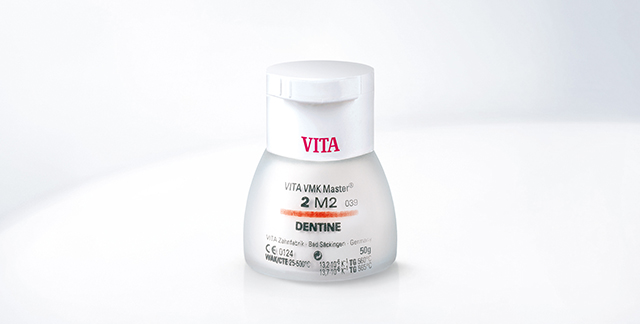
 It appears that you are currently in USA.
It appears that you are currently in USA.
